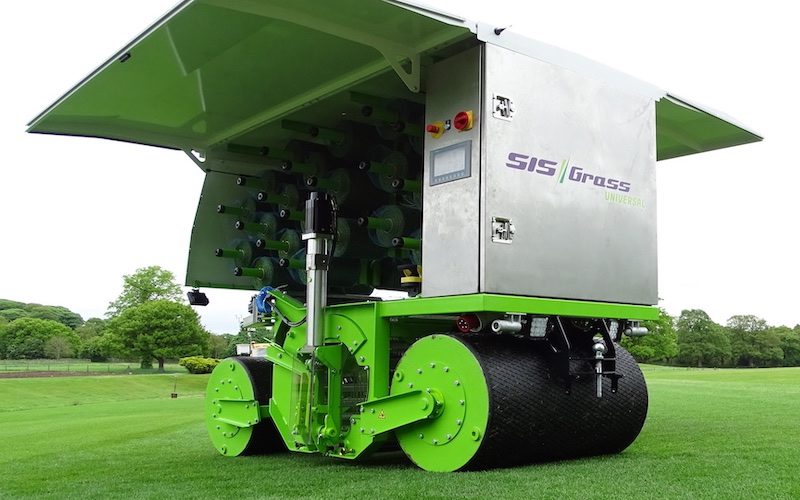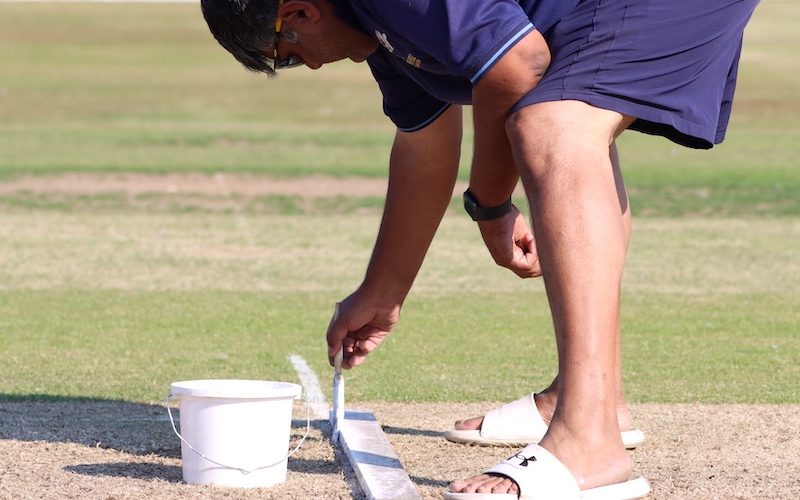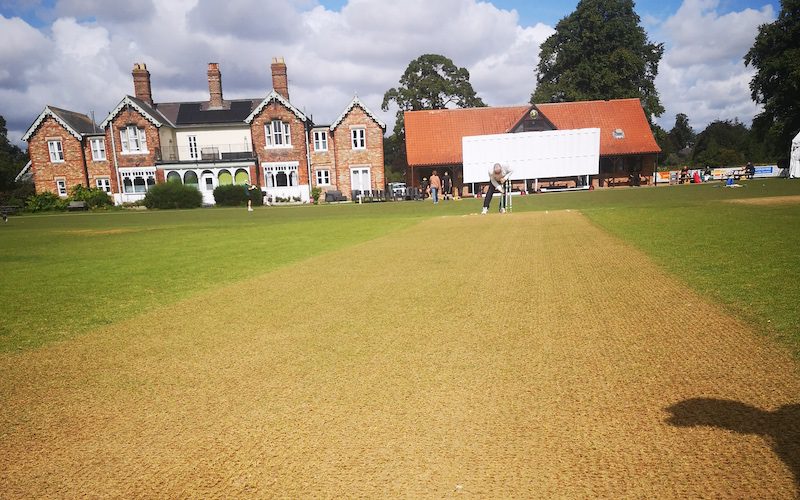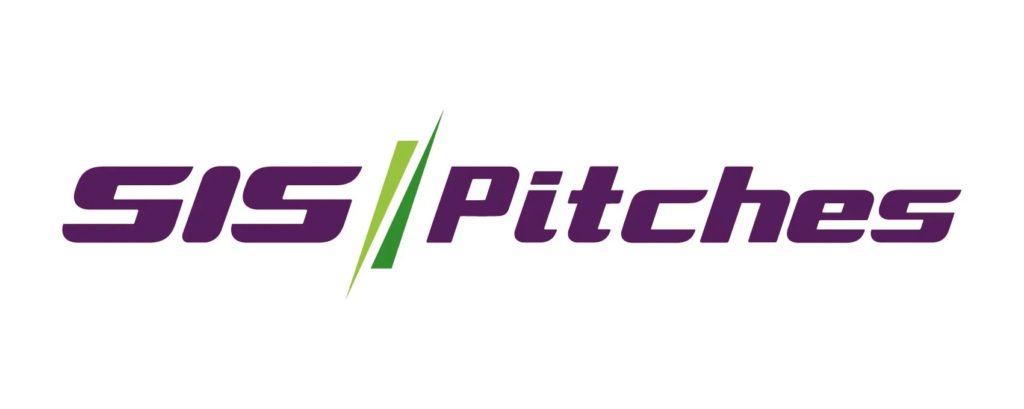In this content collaboration with SIS Pitches, we’ll walk you through all of the common questions relating to buying and installing a hybrid cricket pitch.
If you’re a sports club or a school, or a groundskeeper who is fact-finding, this will be an in-depth guide and you’re welcome to email Paul Taylor at SIS Pitches, if you need more information.

What is a hybrid pitch in cricket?
SISGrass cricket pitches are 95% natural grass surfaces that have two-tone polyethylene fibres inserted into the surface at 2cm x 2cm spacings.
Their specialist laser-guided machine punches the yarn into the ground with speed and precision.
It means an SISGrass installation at a cricket club can happen on a single day to minimise disruption, with some of the projects taking just five hours.
What is the difference between a hybrid pitch and a natural pitch?
Installation consists of 2,500 individual SISGrass fibres being inserted per square metre into the
pitch, to support the natural grass.

So, how does a hybrid pitch work?
A hybrid pitch is still overwhelmingly a grass cricket pitch (rather than an artificial strip) so it behaves in that way but with more consistent bounce and the ability to play much more cricket across a season – because the surface is now harder-wearing.
With that durability, hybrid cricket pitch maintenance becomes easier and less time-consuming.
While it will still need care and attention, there is less need for running repairs whereas with grass, it can tear up in wet weather or there are often foot holes to fill in at the creases.
Having visited various clubs with SIS hybrids, it is astonishing to see the lack of damage after many games.
What are the benefits of a hybrid cricket pitch?
- Improved surface durability and profile stability
- Helps to create and maintain a consistent playing surface
- Reduced wear helps to maintain a greater grass coverage
- Reduces bowler foot holes and crease damage
- Reduces repair works after play
- Faster grass recovery time and extended hours of play
- Stronger post-renovation grass establishment
- Aesthetically they look like natural turf, unlike full size standard non-turf pitches

How long does a hybrid cricket pitch last?
As you’d expect from a surface that may vary from club to club in its usage, the longevity will depend.
A broad estimate would be 7-10 years with a minimum expected of 7 years if the pitch is well looked after and has a reasonable number of matches played on it.
Your cricket club can expect to host many more games than it currently does – which is what you’re investing in and so it becomes an equation of cost over time saved and the other benefits.
How much does a hybrid pitch cost?
Pricing may vary from club to club depending on the location so is done very much on a client-by-client basis. However, the cost is now less of an inhibitor to clubs and the more pitches you have installed, the cheaper each one becomes.
It’s not as expensive as you might expect, but get in touch and SIS Pitches will give a very competitive custom-made quote.
Cricket clubs sometimes have one and swap between fully grass and hybrid during a season while others prefer to buy two so that they can have more matches on hybrids.
As a guide (which will vary), cricket clubs we’ve interviewed tend to use a hybrid strip for half a season if it is used each Saturday, as well as some additional midweek games.
Another major advantage of the hybrid pitches is the provision for practice on the wickets at the ends of the main cricket square (utilising a roll-on net cage), and clubs have seen a huge benefit from this approach in terms of the performance quality of the surface over a longer period of time.

How can your club fund a hybrid?
While buying hybrid cricket pitches is an investment that needs thought, planning and fundraising and/or sponsorship, it is something that many clubs can and do achieve.
While there are no ECB/ central funding pots for hybrid cricket pitches for 2024, the body of evidence as to the positives from international, county and now club venues is considerable.
They are relatively new for the grassroots game but SISGrass hybrid pitches are approved by the England & Wales Cricket Board for domestic one-day formats.
Clubs I’ve spoken to fund hybrid pitches in a variety of ways.
Some have a specific hybrid sponsor like Clifton Alliance. You could put together a proposal with the benefits, cost and expected outcomes. Getting more kids and adults playing at your club through a hybrid is a goal that a sponsor can back and be justifiably proud of.
There may well be local and national grants where a hybrid could attract a successful bid. It undoubtedly increases participation, can enable more community involvement and has a health and wellbeing angle too.
Some of the higher value and most impressive fundraising efforts I’ve seen in club cricket come from crowdfunding.
It is a perfect platform for funding a hybrid. Here’s a past fundraising example from New Rover for their nets.
Clubs often use a combination of grants, sponsors and support from members. As ever, it’s about juggling different priorities.
If you need help and advice, your county board (Yorkshire Cricket Board contacts are split into each region) can update you on the latest news and avenues to think about.
Cricket Yorkshire has also worked with Angus Martin of The Name of the Game who can offer his thoughts on other options from supermarket schemes to council initiatives.

Which cricket clubs have had hybrid cricket pitches installed?
If I were in your shoes as someone who might be interested in a hybrid, I’d be doing my research, the due diligence and talking to cricket clubs who have had them installed.
Clubs often plan for the next five years (those with Clubmark status are required to do so), so here’s a question – could a hybrid be in your future plans? What would that look like and where does that sit with other ambitions?
Here in Yorkshire, cricket hybrids are used at all levels of the game. From Richard Robinson and his team at Yorkshire County Cricket Club to John Dodds at Scarborough Cricket Club.
From Hymers College in East Yorkshire to the University of Leeds’ Sports Park Westwood facilities, upgrades are happening all of the time. More clubs are set to have hybrid pitches installed before umpires call ‘play’ on the 2024 season.
In club cricket, I’ve interviewed:
🏏 Bradford Park Avenue
🏏 Clifton Alliance
🏏 Sowerby Bridge

There are many others across leagues from Woodlands and New Farnley in the Bradford Premier League to Ilkley, Kirkstall Educational and North Leeds in the Aire-Wharfe League.
York Cricket Club (Yorkshire Premier League North) and Wykeham (Scarborough Beckett Cricket League) also spring to mind.
While not the first in the country to have them, it’s fair to say that Yorkshire has since been at the forefront of hybrids in club cricket.
The overwhelming feedback has been positive with clear advantages in terms of more cricket and pitch maintenance.
But, it goes beyond that. It’s a harder thing to quantify but many extra games bring visitors to the club who spend in the bar or buy food. It could introduce new members or volunteers to your club and potential sponsors.
We hope this guide has helped answer the kind of questions you have and the next step is to have a chat with SIS Pitches for anything specific you’d like to know.

Get in touch with SIS Pitches
If you’re a club or school interested in hybrid cricket pitches and want to know more, just book a free consultation with SIS.
Alternatively, Paul Taylor is the person to talk through your club’s pitch requirements and how to get the best from what you need.
His email is [email protected] or 07984 348976.
To follow SIS Pitches on Twitter, they’re @SISPitches or you can ‘Like’ the SIS Pitches Facebook page for news as it happens.
This is a sponsored article for SIS Pitches – if the mood takes you, click to read Cricket Yorkshire’s policy on sponsored content.
- 2026: Predictions and trends for grassroots cricket - December 19, 2025
- Cricket Gifts: The shortlist full of surprises[2026] - December 12, 2025
- 6 ways for cricket clubs to earn with easyfundraising - December 10, 2025